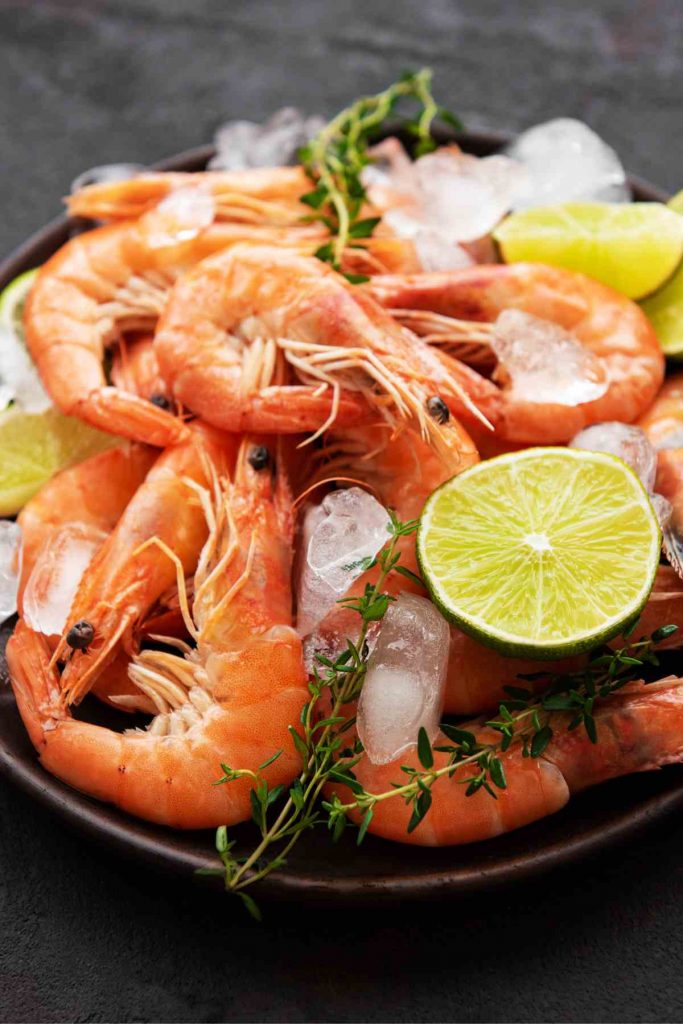Shrimp are delicate creatures that require careful attention to their internal temperature for optimal health and flavor. Whether you're a shrimp farmer, a chef, or a seafood enthusiast, understanding the internal temp for shrimp is crucial for ensuring their quality and safety. This article will explore the nuances of shrimp internal temperature, including its importance, factors affecting it, and how to measure it accurately.
Shrimp is a beloved seafood choice worldwide due to its versatility and nutritional benefits. From grilling to boiling, shrimp can be prepared in various ways, but maintaining the right internal temperature is key to achieving the desired texture and taste. This guide will delve into the science behind shrimp internal temperature and provide practical tips for managing it effectively.
In this article, we will cover everything you need to know about the internal temp for shrimp, including its role in cooking, storage, and overall shrimp health. Whether you're a professional chef or a home cook, this information will help you elevate your shrimp dishes to the next level while ensuring safety and quality.
Read also:Lacy Lennon The Rising Star In The Entertainment Industry
Why Internal Temp for Shrimp Matters
The internal temp for shrimp plays a critical role in determining its safety and palatability. Proper temperature management is essential to prevent foodborne illnesses and ensure the shrimp retains its flavor and texture. Below are some reasons why the internal temp for shrimp is so important:
- Food safety: Cooking shrimp to the appropriate internal temperature kills harmful bacteria such as Salmonella and E. coli.
- Texture and taste: Overcooking or undercooking shrimp can negatively affect its texture and flavor. The right internal temp ensures a tender and juicy result.
- Shelf life: Maintaining the correct internal temperature during storage can extend the shelf life of shrimp and prevent spoilage.
By understanding the significance of internal temp for shrimp, you can make informed decisions about how to handle and prepare this popular seafood.
Factors Affecting Shrimp Internal Temperature
Several factors influence the internal temp for shrimp, and being aware of these can help you achieve the best results. Here are the primary factors:
1. Size of the Shrimp
Smaller shrimp cook faster and reach their internal temperature more quickly than larger ones. It's essential to adjust cooking times based on the size of the shrimp to avoid overcooking or undercooking.
2. Cooking Method
Different cooking methods affect how heat is transferred to the shrimp, impacting the internal temperature. For example, boiling transfers heat faster than grilling or baking.
3. Starting Temperature
The temperature of the shrimp before cooking also plays a role. Shrimp that start at room temperature will cook faster than those taken directly from the refrigerator or freezer.
Read also:Experience The Thrill Of Skydiving In San Diego Your Ultimate Adventure Guide
Understanding these factors allows you to better control the internal temp for shrimp during preparation.
How to Measure Internal Temp for Shrimp
Measuring the internal temp for shrimp accurately is crucial for ensuring safety and quality. Follow these steps to measure shrimp internal temperature effectively:
- Use a food thermometer: Insert the thermometer into the thickest part of the shrimp, avoiding the shell if present.
- Check multiple shrimp: Since shrimp can vary in size, it's important to check the temperature of several pieces to ensure they are all cooked properly.
- Look for the right temperature: The USDA recommends cooking shrimp to an internal temperature of 145°F (63°C).
Using a reliable food thermometer is the best way to ensure your shrimp reaches the correct internal temp for optimal safety and taste.
Proper Cooking Techniques for Shrimp
Cooking shrimp to the right internal temp requires using the appropriate techniques. Below are some popular methods for cooking shrimp and how they affect internal temperature:
1. Boiling
Boiling is one of the quickest ways to cook shrimp. Bring a pot of water to a boil, add the shrimp, and cook until they reach an internal temp of 145°F (63°C).
2. Grilling
Grilling imparts a smoky flavor to shrimp. Preheat your grill to medium-high heat, add the shrimp, and cook until they reach the desired internal temp for shrimp.
3. Baking
Baking shrimp in the oven is a hands-off method that results in evenly cooked shrimp. Place the shrimp on a baking sheet, season as desired, and bake until they reach an internal temp of 145°F (63°C).
Each method has its own advantages, but all require careful attention to internal temp for shrimp to achieve the best results.
Storage and Handling Tips for Shrimp
Proper storage and handling are essential for maintaining the internal temp for shrimp and ensuring its safety. Follow these tips to keep your shrimp fresh and safe:
- Store shrimp in the coldest part of your refrigerator at or below 40°F (4°C).
- Freeze shrimp if you don't plan to use them within two days, ensuring they are stored at 0°F (-18°C) or lower.
- Thaw shrimp in the refrigerator or under cold running water to prevent bacterial growth.
By following these storage guidelines, you can help maintain the internal temp for shrimp and preserve its quality.
Common Mistakes to Avoid When Cooking Shrimp
Even experienced cooks can make mistakes when cooking shrimp, which can affect the internal temp for shrimp and the overall outcome. Here are some common mistakes to avoid:
1. Overcooking
Overcooking shrimp can lead to a rubbery texture and loss of flavor. Monitor the internal temp for shrimp closely and remove them from heat as soon as they reach 145°F (63°C).
2. Not Seasoning Properly
Underseasoning can result in bland shrimp. Use herbs, spices, and marinades to enhance the flavor while ensuring the internal temp for shrimp is reached.
3. Ignoring Food Safety Guidelines
Failing to follow food safety guidelines can result in foodborne illnesses. Always cook shrimp to the recommended internal temp for shrimp to ensure safety.
Avoiding these common mistakes will help you achieve perfectly cooked shrimp every time.
Health Benefits of Shrimp
Shrimp not only taste delicious but also offer numerous health benefits. Understanding the internal temp for shrimp is part of enjoying these benefits safely. Here are some of the health advantages of consuming shrimp:
- Rich in protein: Shrimp are a high-protein food, making them an excellent choice for those looking to build muscle or maintain a healthy weight.
- Low in fat: Shrimp are low in fat, particularly saturated fat, making them a heart-healthy option.
- High in omega-3 fatty acids: Shrimp contain omega-3 fatty acids, which support brain and heart health.
By cooking shrimp to the correct internal temp for shrimp, you can enjoy all the health benefits this seafood has to offer.
Recipes Featuring Shrimp
Now that you understand the importance of internal temp for shrimp, here are a few delicious recipes to try:
1. Garlic Butter Shrimp
This classic recipe is simple yet flavorful. Cook shrimp in garlic butter until they reach an internal temp of 145°F (63°C) for a delicious appetizer or main course.
2. Shrimp Tacos
Grill shrimp until they reach the right internal temp for shrimp, then serve them in tacos with fresh toppings for a tasty meal.
3. Shrimp Scampi
Saute shrimp in a garlic and white wine sauce until they reach the recommended internal temp for shrimp for a luxurious pasta dish.
These recipes showcase the versatility of shrimp and highlight the importance of cooking them to the correct internal temp for shrimp.
Conclusion
In conclusion, understanding the internal temp for shrimp is essential for ensuring both safety and quality. By considering factors such as size, cooking method, and starting temperature, you can achieve perfectly cooked shrimp every time. Proper storage and handling are also crucial for maintaining the internal temp for shrimp and preserving its freshness.
We encourage you to share your thoughts and experiences with shrimp cooking in the comments below. Additionally, feel free to explore our other articles for more tips and recipes featuring this delicious seafood. Together, let's elevate our shrimp cooking skills and enjoy the many benefits this versatile ingredient has to offer!
Table of Contents
- Why Internal Temp for Shrimp Matters
- Factors Affecting Shrimp Internal Temperature
- How to Measure Internal Temp for Shrimp
- Proper Cooking Techniques for Shrimp
- Storage and Handling Tips for Shrimp
- Common Mistakes to Avoid When Cooking Shrimp
- Health Benefits of Shrimp
- Recipes Featuring Shrimp
- Biography
- Conclusion
References
The information in this article is supported by data from reputable sources, including the USDA and various culinary experts. For more detailed information, please refer to the following references:
- USDA Food Safety and Inspection Service
- Food and Drug Administration
- Seafood Health Facts

